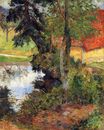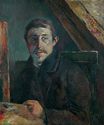Paul Gauguin - Self Portrait 1885
 |
 |
 |
 |
 |
 |
 |

Self Portrait 1885
65x54cm oil/canvas
Kimbell Art Museum, Fort Worth, Texas, USA
The image is only being used for informational and educational purposes
<< Previous G a l l e r y Next >>
From Kimbell Art Museum, Fort Worth:
Gauguin assumed his role as renegade artist in 1885. Rather than remain jobless in Copenhagen with his Danish wife and their five children, the former stockbroker decided now to return to Paris to follow his restless artistic conscience. Painted in Denmark just before reaching this momentous decision in his life, this painting is both somber and defiant in mood and is the first of the many self-portraits in which Gauguin sought to explore his dark inner psyche. Examination of the Kimbell painting under infrared light and with radiographs has revealed that Gauguin made important changes in his self-image as he developed it ever more starkly. At first he portrayed himself in profile and included reproductions of his own paintings on the background wall. Turned to confront the viewer in the final work, he shows himself left-handed, like his image in a mirror, crowded in an attic space with a slanted beam, and cold, with the lapels of his heavy jacket wrapped together. Only his piercing eye escapes the bleak atmosphere. When he made a self-portrait for his new friend Vincent van Gogh, in 1888, he compared himself to Jean Valjean, the criminal hero of Victor Hugo’s Les Miserables: “It is the face of an outlaw, ill-clad and powerful like Jean Valjean—with an inner nobility and gentleness . . . . As for this Jean Valjean, whom society has oppressed, cast out—for all his love and vigor—is he not equally a symbol of the contemporary Impressionist painter? In endowing him with my own features, I offer you—as well as an image of myself—a portrait of all wretched victims of society who avenge us by doing good.”